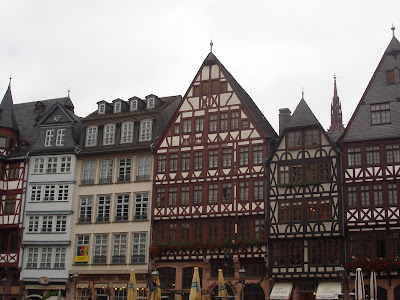Frankfurt is a city that most travelers tend to just pass through because its airport is one of the world's busiest, and people don't end up visiting the city because they are at the airport to just catch a connecting flight. Back in 2007, I decided to spend a day in the city and explore it. I discovered that it's a charming city, with beautiful city squares, magnificent churches and world class museums. I was pleasantly surprised and was very happy with my decision to spend a full day exploring what all it had to offer.
Frankfurt has a
population of over 735,000, and is Germany’s 5th most populated city after Berlin, Hamburg, Munich and
Cologne. It is the capital of the state of Hesse. It lies along the river
Main and the city is also known as Frankfurt Am Main.
Frankfurt was one of the main cities
of the Holy Roman Empire. From 1562 onwards, German kings were crowned in
Frankfurt’s Dom, a practice started by Maximilian II. After the fall of the
Holy Roman Empire in 1805, Frankfurt became a part of the principality of Afschaffenburg.
After Napoleon’s defeat in 1815, Frankfurt became a fully sovereign city state.
It became a part of the German Confederation, and remained so till the Austro
Prussian War in 1866, when it became a part of the Kingdom of Prussia. Since
1945, it has been a part of the state of Hesse.
In 1945, Frankfurt was severely
damaged in World War II, and was painstakingly restored. In the post war years,
the city has gone on to become a powerful financial centre. It also has one of
the world’s largest airports. The city’s infrastructure is world class, and it
has a very efficient underground transportation system.
The Romer
is a building in the heart of the old city. It has served as the City Hall
since the 15th century. The Romer family sold the building to the city council for its
use as the City Hall in 1405, and hence the name. In 1944, the Romer with its gabled
roofs was destroyed in World War II and had to be rebuilt.
 |
| Romer (Eastern Side) |
 |
| Romer (Western Side) |
Frankfurter Dom, also known as Kaiserkirche Sankt Bartholomaus, was completed in 1550. It has a 95 meter tall spire.
The church was destroyed in a fire in 1867 and then again in World War II, but
was restored each time. During my visit, there was extensive renovation going on, and that hindered my ability to photograph the church's grand exterior.
 |
| Crucifixion Panel, Dom |
Goethehaus was the house in which the famous writer was born in
1749. He lived here till 1765, when he moved to university in Leipzig. The
house was with the family till 1795. It is now a museum. It was destroyed in
the war and was restored in 1951.
 |
| Goethehaus |
 |
| Interior, Goethehaus |
The Goethe Statue is a prominent local landmark.
 |
| Goethe Statue |
The Schiller Statue is also a prominent local landmark. The famous German poet lived from 1759 to
1805.
 |
| Schiller Statue |
Frankfurt is a major financial hub and has several skyscrapers, not very characteristic of most European cities. It is jokingly referred to as Mainhattan because of its skyscrapers. The Main
Turm is a 200 meter tall building named after the Main River
that runs through Frankfurt.
With the antenna, its height is 240 meters. The building was completed in 1999.
It has the offices of various large organizations and it also has an
observation deck. The Commerzbank Turm stands at a height of 259 meters.
The twin Deutsche Bank Towers stand at a height of 155 meters.
 |
| Main Turm and Commerzbank Turm |
 |
| Deutsche Bank Towers |
The Boerse
is the Stock Exchange. It is the 10th largest stock
exchange in the world. Outside the building, there is a statue of a Bull and a
Bear. The Stock Exchange has been functioning here since 1879.
 |
| Bull and Bear Statue outside the Boerse |
Alte Oper was completed in 1880
and opened with much fanfare in the presence of Kaiser Wilhelm I. It is a
concert house and former opera house. It was destroyed in 1944 in World War II.
It reopened only in 1981.
 |
| Alte Oper |
Hauptwache is a central square. Its former guard house is now a
popular café.
 |
| Hauptwache |
Stadel
Museum is an art gallery
which was founded in 1817. Its collection has art from the 14th century to the 21st century. Featured artists include Bosch (Ecce Homo),
Botticelli (Portrait of a Young Woman), Rembrandt (The Blinding of Samson),
Vermeer (The Geographer) and Degas (Musicians at the Orchestra).
 |
| Lieberman's Samson and Delilah, Stadel Museum |
Alte Nikolaikirche lies next to Romer in the heart of the
city. The current Lutheran church dates back to the 15th century.
 |
| Alte Nikolaikirche |
Leonardskirche is a Gothic hall church from the 15th century.
 |
| Leonardskirche |
So clearly Frankfurt is so much more than just a commercial city with a large airport. I would certainly recommend a day or two to explore the city's gems, prominent among which would be the beautiful Romer, the impressive Dom, the historic Goethehaus and the magnificent Stadel Museum!





































































